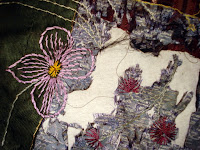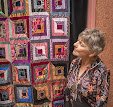A Maryport Quilt goes National!
A very fine quilt,
made in Maryport in Cumbria about 130 years ago, has been accepted into the Collection of
the Quilt Museum
and Gallery in York.
It’s a particularly good example of what is known as the ‘Sawtooth Medallion’
Style, made in red and white fabrics. The red fabric is Turkey red printed in a
rich and complex paisley pattern. Only quilts of exceptional interest and
condition are accepted into the collection so it is an honour that this one has
been accessioned.
The quilt, which
belonged to an established Maryport family, was given to me on long loan a few
years ago. It is in perfect condition because, as I was told: ‘Grandma always
kept it on the best bed, covered with a sheet.’ The owner and I finally decided
that it needed to be offered to the Museum and Gallery so that it could be kept
and preserved to museum standards. I’m delighted to say that it is now on
display at the Museum as part of its current exhibition titled Quilts Then and
Now. Full details of the Museum and opening times can be seen here: http://www.quiltersguild.org.uk/index.php?page=71



